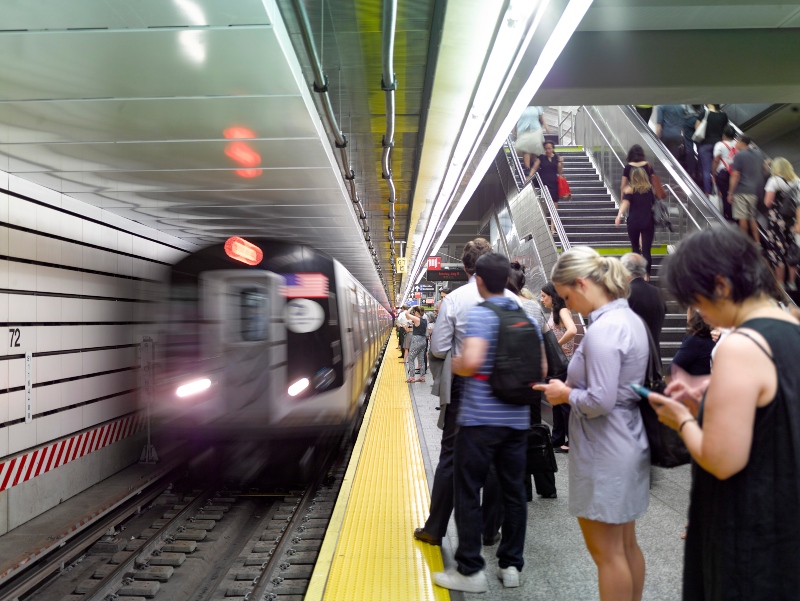Why we must act now: Investing in New York City’s infrastructure is essential for its future
Trendsetting and eclectic, New York City is an economic and cultural world hub, historically driven by its transportation infrastructure – notably the iconic subway system. Long considered the lifeblood of New York City’s economy, the transit system is the marquee example of the benefits of urban rapid transit. In 2019, the transit system connected more than 5.5 million people daily to career, educational and cultural opportunities.
In 2020 however, the transit system bore the brunt of the coronavirus. Ridership and the farebox revenue financing dropped precipitously, putting the transit system and New York City’s economy on the edge of viability. While now rebounding, New York City is continuing to face economic challenges, transit ridership is down 50 percent from 2019, and bringing back ridership will be an ongoing challenge, as the Global Workplace Analytics estimates that 25-30 percent of the workforce may continue to work from home multiple days a week. While decreases in ridership are real and pose an issue, the fact remains that many across New York City will continue to rely on our public transit system – and that its health is vital to the economic and cultural health of our city.
Although ridership may be tenuous, and some may question the wisdom of transit infrastructure investments, I believe that now is the time to invest in transit infrastructure. Simply put, the spending choices we make now will impact our city’s speed and the depth of its recovery. And in New York City, there is no better investment than our transit infrastructure. Here are four factors illustrating the importance of transit infrastructure investment in securing New York City’s future as a world city:
The economy. The wellspring of a healthy city is its economic condition. Infrastructure spending yields important economic dividends – with spending benefits that are even more significant when investing in transportation infrastructure. According to a study for the Business Round Table, an association of chief executives for the United States’ leading companies, every US$1 invested in transportation infrastructure returns US$3.54 in economic impact, a nearly 4:1 ratio, the result of improved efficiency and connectivity.
Developing jobs. As New York’s economy begins to rebound, unemployment is still a concern. Investing in transit infrastructure programs such as the Second Avenue Subway Phase II and an expansion and overhaul of Pennsylvania Station will improve regional connectivity while adding much needed job opportunities. The Economic Policy Institute estimates that every US$100 billion of infrastructure spending adds 1 million jobs. According to Duke University’s Center on Globalization, Governance and Competitiveness, this number doubles when projects are transit related.
Advancing transit’s future. New York City is home to one of the oldest subway systems in the world and incorporates a transit network with one of the world’s largest regional commuter rails. Continuing to modernize and invest in technology that manages density and encourages a return to transit ridership in the age of the coronavirus will keep this network, and in turn New York City’s economy, vibrant for years to come. AECOM’s Transportation Resilient Integrated Passenger Solution (TRIPS) uses new and existing technologies to inform passengers’ decisions with real-time trip planning. It manages congestion at station platforms, and control boarding and alighting which ensures safe arrival at final destinations. The system also enables communication with operators and passengers to help manage transit density, increasing passenger comfort and system ridership.
Resiliency, sustainability and equity. The pandemic raised concerns about difficulties maintaining social distancing on the subway system, factors that some believe might reduce transit use; this however runs counter to New York City’s history. Many believe public transit usage and capacity – and notably on the subways – will continue to expand if we invest in strategies that address convenience, resiliency, sustainability and social equity.
There is an inextricable link between infrastructure investments, and equity, sustainability and resiliency. Programs and projects such as station flood gates promote resiliency, sustainability and transit equity by protecting transit capital investments from damages resulting from climate change and extreme weather. This also promotes equity by keeping the system operational for those relying on it, maintaining their ability to connect to work.
Investing in electrifying buses is one example of a key investment in equity. Implementing the use of these vehicles reduces greenhouse gas emissions that are related to issues of public health. This is particularly important for lower income neighborhoods where bus depots are typically located. Improving the health and well-being of its citizens through projects and programs that reduce emissions will leave lasting legacies to communities across New York City.
Act now. Investing in transit infrastructure affords New York City one of its best chances to stimulate its economy. And the time to act is now. The recently passed Infrastructure Investment and Jobs Act affords us with the ability to reap long-term dividends and improve the system’s long-term health. Investments in subway, MetroNorth and Long Island Rail Road station accessibility and such projects as the Second Avenue Subway Phase II and East Side Access, which will deliver Long Island Rail Road service to Manhattan’s East Side will continue to improve equity, sustainability and in turn our city’s economy. As we continue to manage the coronavirus and its impacts, the economic health and well-being of our city’s residents should be our most pressing concern. The time to act is now.







